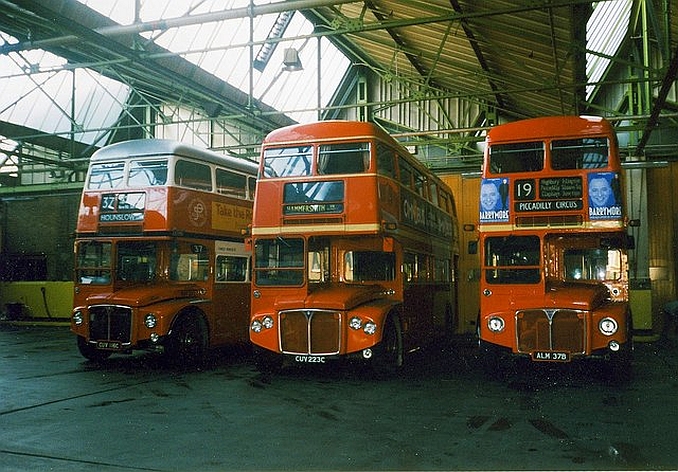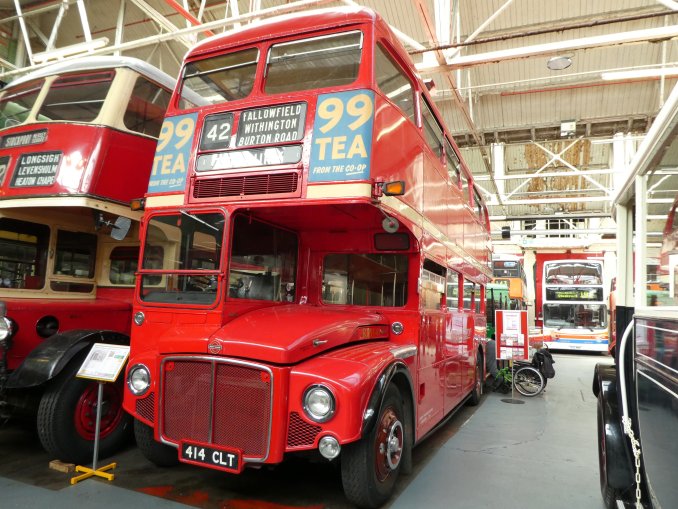The AEC Routemaster History
In 1969 I left Glasgow to work in London. I have travelled many times on Routemasters. These iconic red buses were a familiar site in the city centre and were famous throughout the world.
Quite a number of fleet operators used Routemasters, not just London, even more so when they reached the end of their service life for London Transport. Other fleet operators used the retired Routemasters for their routes as a stop gap until they modernised their fleets.
 London Routemasters: Clive Warneford, CC BY-SA 2.0, via Wikimedia Commons
London Routemasters: Clive Warneford, CC BY-SA 2.0, via Wikimedia Commons
History & Development
- The Routemaster was designed for London Transport by AEC in partnership with London Transport, with the first prototype completed in September 1954.
- The first Routemasters entered passenger service in February 1956.
- Production of Routemasters ran from 1954 until the last vehicles were delivered in 1968.
- A total of 2,876 Routemasters were built.
- Routemaster design combined an aluminium stressed-skin body, two steel subframes (front and rear), and an integral layout to reduce weight and simplify maintenance.
Operators (companies that used the Routemaster besides London Transport)
- Small batches of Routemasters were delivered to the Northern General Transport Company.
- British European Airways (BEA) also took a small number of coach-specification Routemasters.
Variants & Body Lengths
- The standard short-wheelbase RM (often called “RM” or “27 feet 6 inches”) seated about 64 passengers in typical configuration.
- The long-wheelbase RML (30 feet) seated about 72 passengers and was produced to give higher capacity on busy routes.
- Coach and special variants (given factory codes such as CR and CRL types) were produced for express/Green Line and airline use with rear platform doors.
- A single experimental front-entrance prototype with a transverse rear engine was trialled, but the conventional front-engine layout remained the production standard.
Technical Specifications (Key Figures)
- Typical overall widths were 8 feet and heights around 14 feet 4½ inches.
- Lengths were typically 27 feet 6 inches for RM and 30 feet for RML.
- Typical seated capacity ranged roughly from 57 up to 72 depending on variant and interior layout.
- Original engines included the AEC AV590 (9.6-litre) and later AV690 (11.3-litre), with some vehicles fitted with the Leyland O.600 (9.8-litre).
- Rated power for the common AV590 installation was about 115 bhp at 1,800 rpm.
- The Routemaster used an AEC four-speed direct-selection/automatic gearbox with electrical control and air operation.
- Braking was by continuous-flow power hydraulic systems and steering was power assisted with a generous turning circle.
- Typical unladen weight figures are shown around 7–8 long tons with laden weights around 11–12 long tons depending on model.
Construction & Coachbuilders
- The Routemaster was built as an AEC (Associated Equipment Company) product with bodywork primarily by Park Royal Vehicles.
- Other coachbuilders involved in building Routemaster bodies included Metro Cammell Weymann and Eastern Coach Works for certain batches and coach variants.
- The Routemaster’s body structure used an aluminium stressed-skin construction to save weight combined with separate steel front and rear subframes.
Production & Numbering Details
- Routemasters were assembled in the UK (notably Southall) with chassis/body integration under AEC and Park Royal arrangements.
- Fleet numbering used the RM (and RML/RM-class) series for London Transport allocations (for example RM1737 delivered in 1963).
In-Service History, Withdrawal & Heritage
- Routemasters remained in daily service in London from 1956 until the main fleet withdrawals were completed in December 2005.
- TfL (Transport for London) later ran two central London heritage Routemaster routes until 2019, after which Routemasters were removed from TfL contract services.
- Many Routemasters survive in preservation, with heritage operators, private companies and event services using restored examples.
Retrofits, Rebuilds & Modernisations
- Several Routemasters were retrofitted with later diesel engines (Cummins, DAF, Iveco, Scania) during life extensions and preservation.
- Some Routemasters were rebuilt into hybrid or modified vehicles for heritage/charter use, but the original mechanical layout remains the defining characteristic.
Preservation State
- There are roughly 1,230 surviving examples (figure cited by preservation groups and registries as of recent counts).
The ‘might-have-been’ Manchester Routemaster
This is a section from a post I recently published when I visited the Museum of Transport Greater Manchester in March 2025. Among the many well preserved buses was this Routemaster, seemingly a long way from home.
This text was taken directly from the fact sheet in front of the bus, but due to all the myriad reflections in the garage that sunny day, I could not edit the fact sheet photograph to a readable form.
From time to time, bus operators have always tried out new types either loaned from elsewhere or using demonstrators provided by a manufacturer looking for sales. The London Routemaster was developed specifically for London but a batch was sold to Northern General of County Durham where they were successful. Manchester Corporation decided to try the Routemaster out and borrow RM1414 for two weeks in February 1963, working with Parrs Wood Garage in Didsbury. None were bought by Manchester, but when RM1414 was taken out of service in September 1982, it was presented to the Museum in the November as an interesting ‘might-have-been’.
 Manchester’s Routemaster: © VintageBuses.org — Creative Commons BY 4.0
Manchester’s Routemaster: © VintageBuses.org — Creative Commons BY 4.0
The reason why Manchester rejected the Routemaster
 Manchester’s Routemaster - text: © Transport Museum Greater Manchester
Manchester’s Routemaster - text: © Transport Museum Greater Manchester
Routemasters in Scotland (post London Transport)
When London finally withdrew most of its iconic RM Routemasters in December 2005, several Scottish operators eagerly stepped in, giving the classic red buses a second life far from their original home. In places like Edinburgh, Glasgow, and the Highlands, Routemasters found new roles ranging from sightseeing fleets to heritage services and private hires. For many operators, the appeal was a mix of nostalgia, rugged engineering, and the instant charm the buses brought to tourist routes. Some companies even kept the traditional conductors, adding to the old school atmosphere that visitors loved.
Some Scottish operators that added Routemasters to their fleets
- Clydeside Scottish
- Kelvin Scottish / Kelvin Central, including Magicbus/Kelvin Central
- Strathtay Scottish
- Stagecoach in Glasgow under the Magicbus brand
- The Red Bus: Edinburgh vintage hire/privately run Routemasters
Routemaster RM910 EDS 2881 (1961)
 Routemaster RM910 (1961) at Bridgeton Bus Garage, Glasgow: © VintageBuses.org — Creative Commons BY 4.0
Routemaster RM910 (1961) at Bridgeton Bus Garage, Glasgow: © VintageBuses.org — Creative Commons BY 4.0
 Routemaster RM910 (1961) at Bridgeton Bus Garage, Glasgow: © VintageBuses.org — Creative Commons BY 4.0
Routemaster RM910 (1961) at Bridgeton Bus Garage, Glasgow: © VintageBuses.org — Creative Commons BY 4.0
- Old Registration Number: WLT 910
- Chassis Type: AEC Routemaster
- Chassis Number: RM910
- Body Type & Seating: Park Royal H36/28R
- Body Number: L5352
- Original Operator: London Transport (RM910)
- Scottish Operator: Kelvin Scottish
- Fleet Number: 1929
- Location: Glasgow Vintage Vehicle Trust’s Bridgeton Bus Garage
Routemaster WLT 835 RM835 (1961)
 Routemaster RM835 photographed at Bridgeton Bus Garage: © VintageBuses.org — Creative Commons BY 4.0
Routemaster RM835 photographed at Bridgeton Bus Garage: © VintageBuses.org — Creative Commons BY 4.0
- Registration Number: WLT 835 (fleet no. RM835)
- Original Operator: London Transport
- Date New: July 1961
- Chassis Type: AEC Routemaster
- Body Type: Park Royal 28/36
- Last Operator: Clydeside Scottish (withdrawn from service in 1990)
- Preserved By: The Clydemaster Preservation Group
- Location: Can sometimes be seen at GVVT’s Bridgeton Bus Garage in Glasgow
Routemaster RM2121 (1965)
 Routemaster RM2121 at GVVT’s Bridgeton Bus Garage: © VintageBuses.org — Creative Commons BY 4.0
Routemaster RM2121 at GVVT’s Bridgeton Bus Garage: © VintageBuses.org — Creative Commons BY 4.0
- Registration Number: CUV 121C
- Chassis Type: AEC Routemaster
- Chassis Number: RM2121
- Body Type & Seating: Park Royal H36/28R
- Body Number: L5352
- Original Operator: London Transport
- Fleet Number: RM2121
- Location: Glasgow Vintage Vehicle Trust’s Bridgeton Bus Garage
When this Routemaster was new, it operated from the Bow Garage in East London for 14 years. In 1987 it was sold to the Glasgow-based Magicbus fleet. The bus was repainted into the colourful Magicbus livery. Magicbus operations were then sold to Kelvin Central Buses in 1992.
The vehicle was later acquired for preservation and was loaned to the Clydeside company and painted in the red/yellow Clydeside livery. The vehicle bus only spent a short time with Clydeside and was changed back into its original London Transport livery.
Sources
- Flikr: Clydemaster Preservation Group
- Wiki: AEC Routemaster
- Routemaster Association
- Park Royal Vehicles
- London Transport Museum: Routemaster
- Wiki: Scottish Clydeside Routemasters
- Video: Strathtay Routemasters in Perth
- Glasgow Vintage Vehicle Trust Stock List
